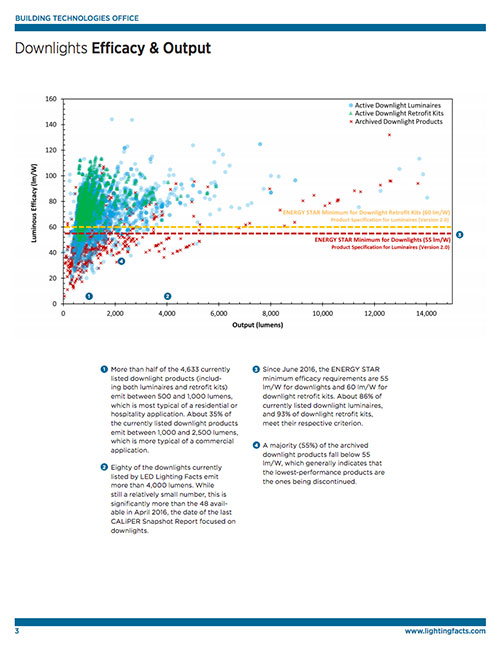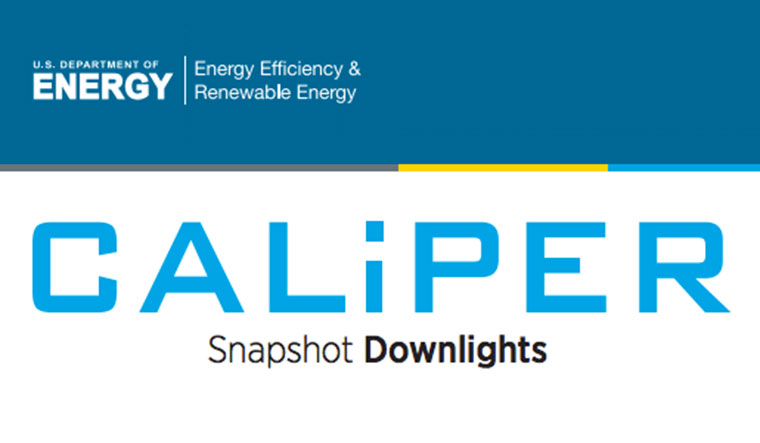Downlights are a staple of residential, hospitality, and commercial lighting, usually providing ambient illumination but sometimes focal lighting. Originally, downlights featured directional incandescent/halogen lamps — although in some cases, omnidirectional lamps were used, with substantial reductions in efficiency. Later, CFL downlights became a dominant part of the market, offering higher efficacies and longer lifetimes, but they often had low luminaire efficiency due to the omnidirectional lamp emissions, as well as some lighting-quality issues. Because of the relatively low efficiency of incumbent technologies, downlighting was among the earliest lighting applications where LEDs offered competitive performance.

DOE’s CALiPER program has released a new Snapshot report on LED downlights. The last such Snapshot was released in April 2016. In the 15 months since then, LED technology has continued to progress, which is reflected in the data available through LED Lighting Facts®, which showcases LED products for general illumination and is the source upon which all Snapshots are based.
The number of available LED downlight products is increasing, along with the mean efficacy. Today, based on photometric performance alone, there appears to be an LED downlight to fulfill just about every need. It’s reasonable to suggest that the LED downlight category has reached maturity, after being one of the first market segments to see viable products that clearly beat the competition from other source types. With a current mean efficacy of 69 lm/W and products reaching as high as 144 lm/W, LED downlights are substantially more energy efficient than their halogen and CFL counterparts. A large percentage of LED downlights also offer high color fidelity and good lighting quality in general — which CFL downlights don’t usually deliver.
The efficacy of LED downlights is lower than for most other product categories, although it’s higher than for downlights that use conventional light sources. About 50% of the downlights listed with LED Lighting Facts have a luminous efficacy greater than 70 lm/W, with only 2% above 100 lm/W. The mean efficacy for listed downlight luminaires only increased by 1 lm/W in the past 15 months, while other comparable product types gained between 5 and 13 lm/W. The downlight category features a greater percentage of products with a CRI in the 90s than any other product category in the LED Lighting Facts database.
At their peak in 2011, downlights made up approximately 25% of the luminaires in the LED Lighting Facts database. While the number of listed downlights has continued to increase, reaching over 4,600 today, they now represent only about 8% of the listed luminaires. This decline is not due to poor performance, however. Rather, it’s more likely due to the increasing availability and viability of LEDs in other categories. In fact, the directional output of LEDs remains well-suited for the downlight form factor, allowing for higher efficacy and better lighting quality compared to CFLs. Now, however, the superiority of LED downlights over competing products may be limiting further performance gains, as the industry focuses on other issues, such as cost.
While the 6″-aperture “recessed can” is the predominant type, the LED Lighting Facts downlight category encompasses a wide variety of products, including those with either round or rectangular apertures ranging in width from approximately 2″-12″. It includes standard integrated-LED downlights (over 3,100 products), as well as retrofit kits (over 1,500 products) that are intended for insertion into an existing housing. With output ranging from a few hundred to more than 14,000 lumens, it’s clear that the products in the downlight category (encompassing both luminaires and retrofit kits) are intended for a variety of applications.
While LED downlights can be lauded for the diversity of options and superiority over legacy light sources, their performance still lags behind that of many other LED luminaire categories. Troffer, linear, directional, wallwash, and industrial luminaires all have higher mean (and maximum) efficacies — and the gap has increased in the past 15 months. The relatively low performance of conventional halogen and CFL downlights provides less incentive for continued efficacy gains in LED downlights, compared to luminaire types competing against linear fluorescent or high-intensity discharge incumbents. Some of the discrepancy is also due to different optical requirements; when additional optical materials are needed to shape the light distribution and/or reduce glare, efficiency is generally reduced. Finally, downlight minimum-efficacy criteria for ENERGY STAR qualification (55 lm/W for luminaires, 60 lm/W for retrofit kits) are substantially lower than the efficacy thresholds for other product categories, which are covered under the DesignLights Consortium™ Qualified Products List. Because qualification criteria are typically based on currently available products, there’s potential for stagnation in thresholds unless other factors influence product development.
None of this completely explains why the increase in mean efficacy for downlight luminaires over the past 15 months (1 lm/W) lags those for troffers (7 lm/W), industrial luminaires (13 lm/W), linear luminaires (10 lm/W), directional luminaires (10 lm/W), wallwashers (13 lm/W), and decorative luminaires (5 lm/w). The latter three product types are a particularly relevant comparison, with similar application demands and form factors. There are many factors that influence product efficacy, but this trend with downlights is concerning. The importance of efficacy gains is not solely related to energy savings. Improved LED package efficiency can simplify thermal management and allow more flexibility in product design, ultimately reducing product cost. With the average LED Lighting Facts-listed downlight at just over one-third of the DOE target for efficacy for LED luminaires (203 lm/W by 2025), there’s substantial room for continued performance gains, which should not be overlooked.
Tagged with Department of Energy, downlights, LED, lightED
